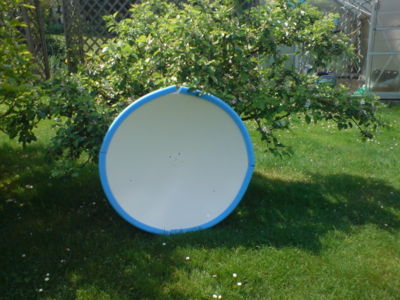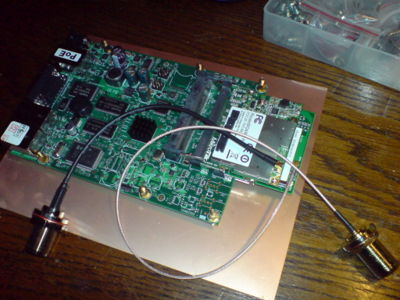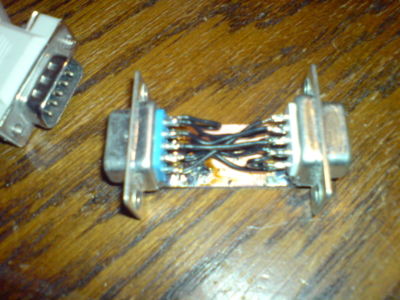High Performance WIFI link
Inhaltsverzeichnis
1 Project goals
This is the master project of all these WIFI link projects. All the other projects only served for acquiring according knowledge, but this time, we'll do the real thing: Set up a high speed link over really long distance. We're still looking for a link partner position. Initially we hoped to put the dish on top of Fachhochschule Regensburg, but it seems that this is not possible for organisational reasons. Eventually, we intend to hook up to the emerging HAMNET Amateur Radio Highspeed Backbone that is currently being built in Austria and the south of Germany.
The DARC district Oberbayern has decided to spend 5000 Euros to buy a number of sets of exactly the type of hardware we're using. Oberbayern is intending to set up a backbone infrastructure across southern Bavaria, and we hope to lead the network a bit northward to Oberpfalz. Yet, the big goal will need some more and financially better equipped carriers and clearly exceeds my private focus.
Precursors of this project are these projects:
Milestones of this project
- Link over 30 kilometers
- Long distance link, possibly a direct link to Austria.
Role-Models:
2 Hardware
We have the same hardware on both sides:
- 1 meter diameter parabolic dish from Ebay
- Mikrotik RouterBoard 433
- WLM54SAG MiniPCI WLAN Interface
- Compex WLM54SAG
- 200mW (23 dBm)
- Atheros AR5414 Chipset
- 2 x U.FL Anschluss
- 802.11a/b/g
- R5H Mikrotik HighPower WLAN interface
- Custom Frequency License to transmit within the Amateur Radio bands
Cost estimate:
- dishes 60 Euro
- Router hardware 430 Euro
- several working hours
3 Software
Let me collect some links beforehand:
- http://wiki.oevsv.at/images/1/13/SetUpBB.pdf
- http://multimedia.oevsv.at/geiersberg2008/Projekt-Alan-DigitalerBackboneOE-VortragGeiersberg2008.ppt
4 Some considerations
4.1 Using preamps vs. PAs
In a discussion on Saturday 09.05.09 we found out that the receiver sensitivity of the WIFI cards we're using is far below all standards known for amateur radio devices. The specification says that the sensitivity is as low as -79 dB for 54 MBit/s connections (referring to a 22 MHz broad signal). As opposed to the transmission power and the prospected gains from the dish, the transmission path is not the side that will deserve our main attention: Enhancing the reception path will promise the highest gains.
Since it was our initial plan to place the router board directly into the focus of the dish, we decided against it, on grounds that we intend to use a highly selective preamplifier, just in the focus of the dish. Given that, the router board doesn't need to be in the focus any longer. Having less weight out there with half a meter of leverage, our dish will also gain more mechanical stability.
So it will be the task of Bernd, DJ6PA, to construct the ring exciters and the pair of preamplifiers - one for 13cm and one for 6 cm.
Given that we will be using preamplifiers anyway, we can live with the 0.5 dB loss of the H2000 cable that connects the preamp in the focus and the router board.
4.2 Mechanical stability vs. propagation angle
Our pair of dishes has a diameter of 1 meter. Sure, this will give us a gain of about 26 dB on the 6cm band and almost as much on the 13cm band. But such big dishes have a disadvantage: The propagation angle is extremely small. We calculate less tha 1 degree on 6 cm. The transmitted beam is thus very, very narrow. Since the dish is quite big nevertheless, it is very prone to vibrations caused by the wind.
With an estimated propagation angle of about 1 degree, in 30 kilometers distance the diameter of the beam will just be about 500 meters. So only slight vibrations of the mounts will cause the beam to be off the target. It will be vital for a stable link to mount the disk as mechanically stable as possible, and not just on one side, but on two sides.
As for the next milestone of the project, to set up a link over 30 kilometers, it might be more advisable to try a smaller dish at first. This is also an interesting insight given that we have established connections on 10 GHz between DB0MHB and stations in Regensburg using far less transmitting power and smaller dishes.
5 Installation
5.1 Burdens of the installation
Before you can get access to the device, you need a Nullmodem. I just followed the cabling instuctions given here and it worked from the beginning.
5.2 Pick an operating frequency
- http://www.df3xz.de/Neue_Dateien/Bandpl%E4ne.pdf DF3XZ has a nice overview of bandplans.
I decided to pick the following frequencies for the link experiment:
- DB0MHB side
- 2380 MHz RX
- 5680 MHz TX
- DL8RDS side
- 5680 MHz RX
- 2380 MHz TX
5.3 Pick IPs
- DB0MHB: 44.128.12.10
- DL8RDS: 44.128.12.11
There's a test IP range we're using: 44.128.12.0/24
5.4 Ring Exciters
Antenna construction is probably most visible engineering effort in the entire project. We are constructing a weatherproof pair of concentrical ring exciters for the focus of the dishes.
As the works are advancing, I will provide more information.
5.5 Cases
There's still no case for the devices. I still need to build according PCB boxes which will later need to be weatherproof. And I need to build cases for the ring exciters.
5.6 What's next?
don't know yet. Hold on.


